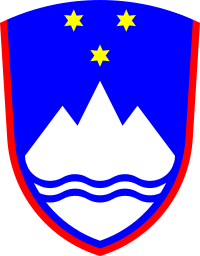Coat of arms of Slovenia
| Coat of arms of Slovenia | |
|---|---|
 |
|
| Details | |
| Armiger | Republic of Slovenia |
| Adopted | 1991 |
| Escutcheon | Azure, issuant from base a mountain of three peaks argent surmounted at nombril point by two bars wavy of the first and ensigned in chief by three mullets Or two and one, all within a bordure gules |
The Slovenian coat of arms consists of a red bordered blue shield on which there is a stylised white Mount Triglav, under which there are two wavy lines representing the sea and the rivers of the country. Above Mount Triglav, there are three golden six-pointed stars. It was designed in 1991 by Marko Pogačnik and adopted on 24 June 1991.
Until the dissolution of Austria-Hungary, the Slovene Lands did not have a coat of arms representing the whole nation, instead it had a different coat of arms for every land.
When the State of Slovenes, Croats and Serbs merged with Kingdom of Serbia, Slovenia got the first real coat of arms, which actually was a heavily modified one from the Serbian Kingdom. The coat of arms presents the Serbian shield with white cross on the left, the Croatian shield on the right and under both there is a blue shield representing Slovenes. An image of the royal Yugoslav coat of arms can be seen on the 10-Yugoslav dinar banknote of 1926.
The coat of arms of the Socialist Republic of Slovenia was designed by Branko Simčič on the basis of the symbol of the Liberation Front of the Slovene Nation. The sea and the mount Triglav motive appeared in the coat of arms of the Socialist Republic of Slovenia, one of six constituent republics of the Socialist Federal Republic of Yugoslavia. The former coat of arms was rounded by wheat with linden leaves and featured a red star at the top. There was also the other coat of arms which presented Yugoslavia as a whole.
The tender for the design of the new coat of arms of Slovenia was published in May 1991. It was won by Marko Pogačnik. He based his design on the understanding of Slovenia as a macroregional entity and on the work by France Prešeren and Jože Plečnik. In regard, to Prešeren, the coat of arms depicts the description of nature given by the poet in his epic-lyric poem The Baptism on the Savica. In regard to Plečnik, the coat of arms follows the coat of arms of Slovenia, carved upon the design by thea architect in 1934 at the column of the Virgin Mary, which stands in front of the parish church in Bled.
...
Wikipedia
